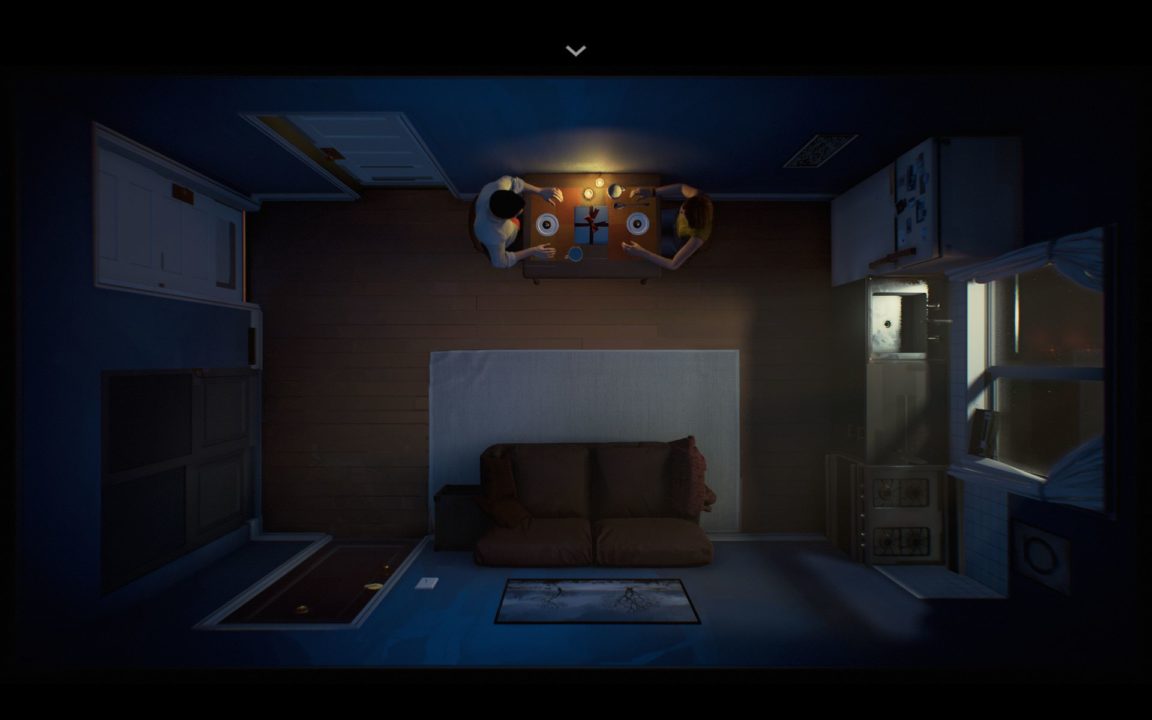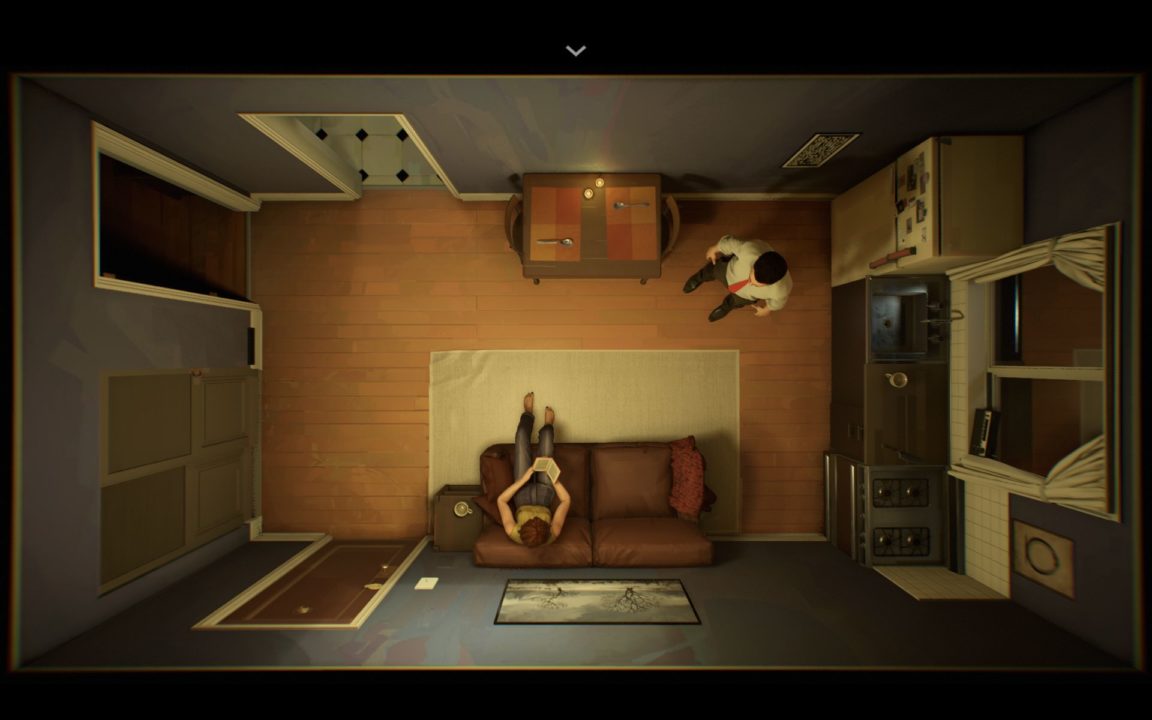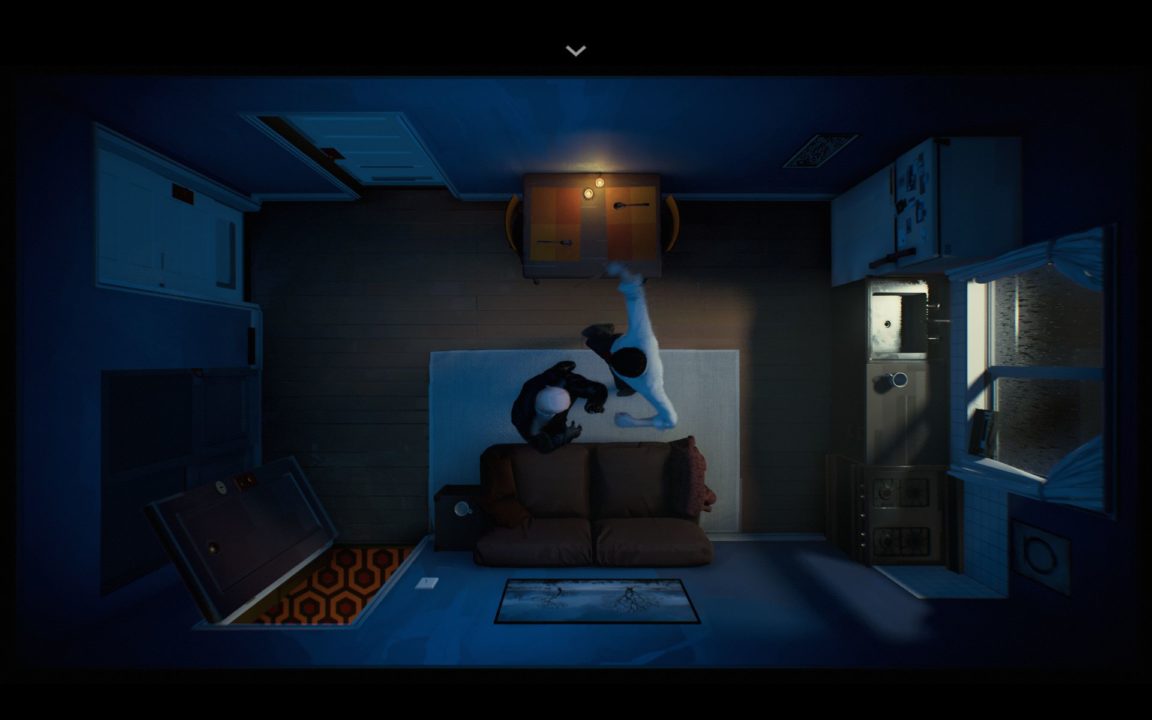Twelve Minutes is an intense, point-and-click style interactive thriller running on a time loop, where everything becomes a little bit clearer and occasionally more complicated with each run. Located in just a small apartment with an almost top-down view Twelve Minutes starts with a cold open and little knowledge of the situation or what is about to unfold. Running in real time, the clock ticks down and only allows a certain amount of time to make decisions or uncover information before an intruder interrupts a dinner between a Husband (the player) and Wife. With its point and click style of movement and use of items, it has a familiar language that is easy to understand.
I have thoroughly enjoyed Twelve Minutes. It is fantastic in both its point-and-click play but also its narrative. The story doesn’t play out traditionally as time passes. The player is asked to uncover the story, gain small bits of information on each loop ready to be presented and used in the next. This is mostly done through conversation and this conversation between the characters feels natural. A player’s decision in what to ask from a set of questions is met with a well-written response. These responses will either progress the player’s understanding of the story or cut them off suggesting there is more to uncover before asking this question. There is some excellent detail in this dialogue that changes depending on the situation, the known information, and also what you’ve already discussed. A response of ‘Who beats you up?’ was given early on. This then added ‘the cop?’ immediately after when the notion of the Cop turning up had been discussed first. These slight changes in the dialogue add to that natural feel and change what the player is hearing enough to not be too repetitive. This is conveyed very well in the voice acting too and apart from Willem Dafoe I did not know of the involvement of the other big-name actors. Daisy Ridley and James McAvoy’s portrayal of the characters is excellent and I could not tell it was either actor playing the parts. As mentioned it feels natural and I’d be interested to know if lines were recorded individually or in a group recording. Willem Dafoe is of course identifiably Willem Dafoe yet this does not detract from the character he plays. They all play their parts very well in an unfolding, intriguing, and at times tense story. Without being able to see the character’s faces with its top-down view the dialogue and how it is expressed by Daisy, James and Willem is fundamental in conveying the characters’ motivations and feelings and is very successful in this.

The point-and-click puzzle play style is well paced. All of the small moves discovered through exploration of the environment or in conversation help to allow a sense of progression. This builds and the story unfolds a little more with each move. Choices on what to do, or what to move never appear wrong. Some choices, in where to place an item or what to say may cut the loop short but this failure progresses the understanding of how the events could play out. There are various big moves early on which will completely change the run of events within the space and these are sign-posted well, again through the environment and conversation. There is a sense of playing off these big moves uncovering information in one scenario to use in the other. A grand puzzle that relies on the actors to play a set path laid out by the choices made. These scenario changes kept the game feeling fresh, something hard to do in one environment with repeated choices. It can also be incredibly intense waiting for events to play out. Hiding in a cupboard to wait for some big bad to move on in horror games can be scary and tense. Hiding and waiting for a trap to be triggered is in ways more intense. Those choices determine the event’s success rather than just waiting for a beast’s AI to move on as it hunts you down. There are also moments where the use of items can be missed and block off the choices and paths taken. This occurs naturally. The Wife may pick up an item to use and it then stays with them until the story may require its presentation. There may have been plans for this item to progress the dialogue. As this cannot happen a better understanding of the sequence of events and choices made is the only outcome for that loop. This is a clever choice on the developer’s part to help the player understand the game better.
Twelve Minutes is a ‘Holy Fuck’ game. By this I mean I have experienced so many ‘Holy Fuck’ moments. With each choice and a sense of progression in the scene something unexpected can happen very quickly, something unplanned which restarts the loop. These come in small movements and big reveals. These reveals had me thinking ‘Holy Fuck’ a lot through the experience. This then elicited some introspection. I thought of all the moves made so far, tried to repeat or perfect the timing, or explore a different path then watch it play out and react as planned. I tried to think ahead, of the potential outcomes, the decisions I’d made. Just when a choice plays out as I think it should, the moment shifts and a character will make a different move, unexpected. ‘Holy Fuck!’ This plays into the animations of the characters too. A choice on how to approach the intruder played out and was ended quickly. I tried the same approach again and the Husband anticipated the move changing the character’s movement. The intruder countered, ‘Holy Fuck’. I tried again, the husband anticipating, the intruder countering, the loop restarts. I tried about five times to do this and when the new loop began a line of dialogue suggested this was not the right approach to take. It was subtle but I gave up and tried something new. This familiarity with the game’s language allows for this exploration and continued experimentation. Everything feels like progress. On occasion, it did feel like I had potentially jumped ahead, that I hadn’t allowed the scene to play out naturally and I was jumping straight into the discovery of items and how to progress. This didn’t feel jarring but more as if a step had been skipped over and an opportunity to discover the clue naturally missed. This meant I was a little all over the place in my loops, having a few seconds to decide what approach to take when they began. I wasn’t consistent and logical in these choices which I put mostly down to the intensity of the situations and how quickly things can appear to go wrong.

Twelve Minutes isn’t without fault. At times text and dialogue overlap a little and events interrupt one another. This is a natural thing to happen, a discussion is cut off by someone else but the transitions between a few of these were not as fluid as others and stuck out. There are also a couple of visual issues too with the pooling of blood but this will only be seen if that path is followed and this a minor gripe. Potentially the puzzles and how to progress the story may not become as apparent in the later moments as they are in the early ones for some players. Solutions aren’t abstract; they just require the correct moves to be made to uncover them. A puzzle within the puzzle.
Visually the game works well for the story. It is crisp and clean with excellent lighting, the small environment is well textured. It has a faux realistic style that doesn’t chase the uncanny valley. The visuals are absolutely second fiddle to the narrative and play but they do not distract or detract from the experience. As with the voice acting the environmental sound and slight musical cues are implemented well and balanced to be more background against the dialogue. It is a well-crafted dynamic environment to experience the story in.
Twelve Minutes also has some great quality-of-life shortcuts that allow the scene to move on quickly and for the player not to have to repeat too many moves. Once some elements have been discovered certain dialogue options will appear. This feels like a natural place where the player has solved a certain amount of the early moves as if those early moves were part of the puzzle now solved and not needed to be repeated. The player can also move time forward quickly. By ‘waiting’ for an event the loop doesn’t need to run through the full real-time for events to take place. Both of these elements allow more time to explore other options in the narrative and experiment for later solutions. Dialogue can also be fast-forwarded with a simple click allowing the pace of the game to keep up with the player and still understanding that everything is being explained, the narrative moves forward and the player can still see how the dialogue unfolds.

With its unique looping play, neat puzzlesque design and fantastic narrative it is a must play for those who enjoy point and click, puzzlers, and narrative-heavy games alike. The ease of play will keep you playing and the story will keep you invested.
Should you play it? Yes
Why… There are not many experiences like Twelve Minutes around. The fantastic writing, acting and story will keep you puzzling away for hours.
But… It is a genre game and those not interested in puzzle-based narrative-heavy games may have a harder time with the loops.
Reviewed on PC/Steam
Developer/Publisher: Luis Antonio/Annapurna Interactive
Playable on: PC/Xbox
Released: 19th August, 2021
Review code provided by Annapurna Interactive








